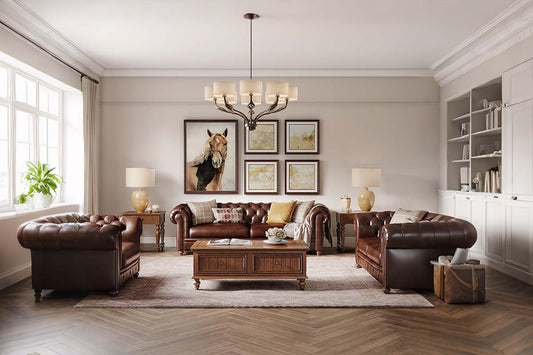
How to Fix a Damaged Computer Desk: A Step-by-Step Guide Inspired by Allen’s Story
Share
For many of us, a computer desk is more than just furniture—it’s the foundation of our daily work routine. And when that desk starts to wear down, it can throw everything off balance. This article walks you through how to repair common desk issues using affordable, accessible tools—all through the lens of a relatable story.

Meet Allen: The Artist Who Worked Through the Damp
Allen is a freelance illustrator living just outside Seattle, where rainy weather is pretty much the norm. Between 10-hour workdays and the region’s constant moisture, Allen started to notice signs of damage on his desk: faded rings from coffee mugs, surface scratches, wobbly legs, and musty-smelling drawers.
“I didn’t think my desk would age so fast,” Allen recalls. “But it turns out that humidity and long hours are a tough combo.”
So he rolled up his sleeves and got to work—literally—learning to repair and maintain the piece of furniture he relies on the most.
Through Allen’s experience, this blog will walk you through everything you need to know about identifying, fixing, and even upgrading your desk using low-cost tools and techniques. Whether you’re dealing with scratches, water damage, wobbly legs, cracked wood, drawer issues, or mold, you’ll find practical fixes and smart maintenance tips to keep your desk in top shape—especially in damp climates.
Common Desk Problems & How to Fix Them
1. Scratches and Surface Wear
The Problem: Allen noticed small but noticeable scratches across his desktop—some from keys, others from heavy use.
The Fix:
- For light scratches, rub a walnut or crayon (in a matching color) along the scratch, then buff with a soft cloth.
- For deep scratches, apply wood filler, let it dry, sand it smooth (start with 320-grit), and finish with stain or a protective clear coat.
Pro Tip: A desk pad or blotter can prevent future wear from keyboards, pens, and cups.
2. Water Stains and Coffee Rings
The Problem: Allen’s favorite habit—drinking coffee while sketching—left white water rings all over the surface.
The Fix:
- Use a hair dryer on low heat to gently evaporate moisture from the stain.
- Mix equal parts olive oil and vinegar, apply to the area, and buff it in circles with a cloth.
- For stubborn rings, a paste of baking soda and toothpaste can lift deeper stains—just don’t scrub too hard.
Pro Tip: Keep coasters handy and wipe any spills immediately.
3. Wobbly or Broken Desk Legs
The Problem: Over time, Allen’s desk started to wobble, making detailed work difficult.
The Fix:
- Loose screws? Tighten them and apply thread-locking adhesive (like Loctite) if needed.
- Wood joints loose? Disassemble, apply wood glue, clamp tightly, and let cure for 24 hours.
- Broken legs? Reinforce with L-brackets or corner braces from a hardware store.
Pro Tip: Use anti-moisture sealant or spray paint on legs if they’re near humid walls or floors.
4. Cracked Wood
The Problem: The edges of Allen’s desktop began to show hairline cracks, especially on the side that faced the window.
The Fix:
- Mix wood glue with sawdust to create filler for small cracks.
- Once dry, sand the surface and reapply finish.
- For larger cracks, you may need to patch the area with a wood slat or strip.
Pro Tip: Keep your desk out of direct sunlight and away from heat vents. Ideal indoor humidity is between 45–60%.
5. Sticking Drawers or Track Issues
The Problem: During Seattle’s wet season, Allen’s desk drawers kept getting stuck.
The Fix:
- Remove the drawers and rub wax (like a candle or bar of soap) on the runners.
- If the metal rails are rusted, consider replacing them with aluminum or stainless steel tracks.
- For wood-on-wood runners, sand lightly and apply wax or silicone spray.
Pro Tip: Upgrade to ball-bearing slides if your current ones feel sticky or uneven.
6. Mold or Musty Smell
The Problem: Allen noticed a faint mildew smell, especially after several rainy weeks.
The Fix:
- Mix equal parts white vinegar and water, wipe affected areas, and dry thoroughly.
- For heavy mold, use isopropyl alcohol or diluted bleach (test first to avoid discoloration).
- After drying, apply anti-mold paint or clear sealant.
Pro Tip: Place moisture absorbers or silica gel packets in drawers. Use a dehumidifier if possible.
Allen’s DIY Repair Kit: Tools You’ll Need
| Tool or Material | Purpose |
|---|---|
| Screwdriver & Hex Wrench | Tighten desk legs, rails, and braces |
| Wood Glue or Carpenter's Glue | Fix loose joints and cracks |
| 320–600 Grit Sandpaper | Smooth scratches, prep for sealing |
| Wood Filler / Sawdust + Glue | Fill deep cracks and dents |
| Hair Dryer (Low Heat) | Remove water rings |
| White Vinegar, Baking Soda, Toothpaste | Clean stains and mold |
| Candle Wax or Bar Soap | Lubricate drawer tracks |
| L-Brackets / Corner Braces | Reinforce weak legs or joints |
| Soft Cloth, Olive Oil, Furniture Wax | Polish and protect wood |
| Moisture Absorber Packs | Control humidity inside drawers |
Choosing the Right Desk for Humid Conditions
| Material Type | Moisture Resistance | Recommended Finish | Ideal For |
|---|---|---|---|
| Solid Rubberwood | Moderate | Polyurethane Sealant | Wood lovers |
| MDF / Particle Board | Low | Waterproof Coating | Budget setups |
| Metal Frame + Glass Top | High | Powder-Coated Metal | Modern workspaces |
| Solid Wood + Epoxy Resin | High | Self-Sealing Surface | Damp environments |
Allen’s Ongoing Maintenance Tips
Here’s how Allen now keeps his workspace in top shape:
- Places rubber or cork pads under each desk leg.
- Wipes down the desk weekly with a dry microfiber cloth.
- Keeps a dehumidifier running during the rainy season.
- Applies furniture wax every six months for added protection.
- Stores a couple of activated charcoal packets in drawers to absorb moisture.
“I can finally draw for hours without worrying if my desk will collapse—or grow mushrooms,” Allen jokes.

When to Repair — and When to Upgrade — Your Office Desk
Not every desk issue means it’s time to buy a new one. If your desktop is wobbly, scratched, or has minor damage, a quick DIY fix with basic tools might restore it to perfect working order. Repairs are ideal when the frame is solid, the design still fits your needs, and you’re looking to save money.
However, it might be time for an upgrade if your current desk no longer supports your workflow. Signs include insufficient space, poor ergonomics, limited cable management, or outdated style that no longer fits your office. Investing in a new desk can boost productivity, improve posture, and bring a fresh sense of motivation to your workspace.
In short: repair when it’s practical—upgrade when it’s transformational.
That’s when it makes sense to upgrade to something sturdier and more comfortable—like POVIMO’s moisture-resistant solid wood desk—built to last and support your workflow long-term.
FAQs: Fixing and Upgrading Your Office Desk
1. Why is my desk wobbly?
Loose legs or uneven floors are common causes. Try tightening screws or adding pads under the legs.
2. Can I fix scratches on the desktop?
Yes! Light sanding and wood oil or polish usually do the trick.
3. Is it normal for desks to creak?
Not really. Creaking often means loose joints—tighten hardware or check for warping.
4. Should I repair or replace my desk?
If your current setup causes discomfort, lacks storage, doesn’t support your monitor ergonomically, or looks outdated, it might be time to switch to a better-quality desk—like a moisture-resistant solid wood option from POVIMO that’s built to last.
5. How can I make my desk last longer?
Keep it dry, avoid direct sunlight, and check hardware regularly. Quality care makes a big difference.
Final Thoughts: You're Not Just Fixing a Desk
Whether you're a freelancer like Allen or just someone who wants their home office to last, investing a little time in desk care makes a big difference. A sturdy, clean, and comfortable workspace can improve your productivity—and your peace of mind.
Have a desk repair tip or story of your own? Share it in the comments—we’d love to hear it!
read more:
How to Tell a Real Wood Executive Desk from a Cheap One: The Ultimate Office Desk Materials Guide
Why a Solid Wood Executive Desk Is the Ultimate Office Upgrade
2025 Amazon Best Selling Office Desks: In-Depth Review & Comparison



